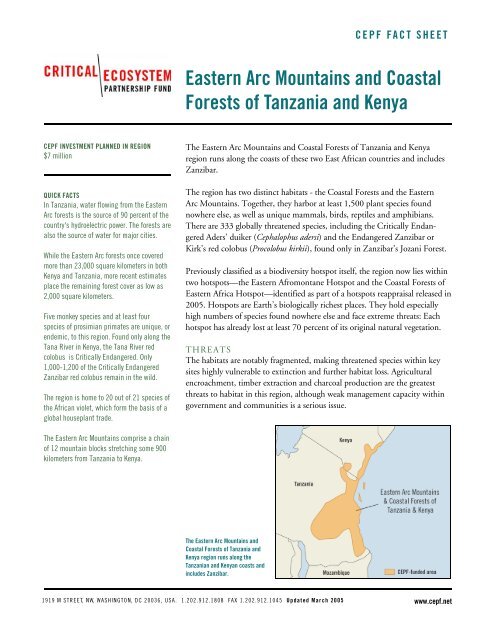Eastern Arc Mountains and Coastal Forests of Tanzania and Kenya ...
Eastern Arc Mountains and Coastal Forests of Tanzania and Kenya ...
Eastern Arc Mountains and Coastal Forests of Tanzania and Kenya ...
Create successful ePaper yourself
Turn your PDF publications into a flip-book with our unique Google optimized e-Paper software.
CEPF FACT SHEET<strong>Eastern</strong> <strong>Arc</strong> <strong>Mountains</strong> <strong>and</strong> <strong>Coastal</strong><strong>Forests</strong> <strong>of</strong> <strong>Tanzania</strong> <strong>and</strong> <strong>Kenya</strong>CEPF INVESTMENT PLANNED IN REGION$7 millionQUICK FACTSIn <strong>Tanzania</strong>, water flowing from the <strong>Eastern</strong><strong>Arc</strong> forests is the source <strong>of</strong> 90 percent <strong>of</strong> thecountry's hydroelectric power. The forests arealso the source <strong>of</strong> water for major cities.While the <strong>Eastern</strong> <strong>Arc</strong> forests once coveredmore than 23,000 square kilometers in both<strong>Kenya</strong> <strong>and</strong> <strong>Tanzania</strong>, more recent estimatesplace the remaining forest cover as low as2,000 square kilometers.Five monkey species <strong>and</strong> at least fourspecies <strong>of</strong> prosimian primates are unique, orendemic, to this region. Found only along theTana River in <strong>Kenya</strong>, the Tana River redcolobus is Critically Endangered. Only1,000-1,200 <strong>of</strong> the Critically EndangeredZanzibar red colobus remain in the wild.The region is home to 20 out <strong>of</strong> 21 species <strong>of</strong>the African violet, which form the basis <strong>of</strong> aglobal houseplant trade.The <strong>Eastern</strong> <strong>Arc</strong> <strong>Mountains</strong> <strong>and</strong> <strong>Coastal</strong> <strong>Forests</strong> <strong>of</strong> <strong>Tanzania</strong> <strong>and</strong> <strong>Kenya</strong>region runs along the coasts <strong>of</strong> these two East African countries <strong>and</strong> includesZanzibar.The region has two distinct habitats - the <strong>Coastal</strong> <strong>Forests</strong> <strong>and</strong> the <strong>Eastern</strong><strong>Arc</strong> <strong>Mountains</strong>. Together, they harbor at least 1,500 plant species foundnowhere else, as well as unique mammals, birds, reptiles <strong>and</strong> amphibians.There are 333 globally threatened species, including the Critically EndangeredAders’ duiker (Cephalophus adersi) <strong>and</strong> the Endangered Zanzibar orKirk’s red colobus (Procolobus kirkii), found only in Zanzibar’s Jozani Forest.Previously classified as a biodiversity hotspot itself, the region now lies withintwo hotspots—the <strong>Eastern</strong> Afromontane Hotspot <strong>and</strong> the <strong>Coastal</strong> <strong>Forests</strong> <strong>of</strong><strong>Eastern</strong> Africa Hotspot—identified as part <strong>of</strong> a hotspots reappraisal released in2005. Hotspots are Earth’s biologically richest places. They hold especiallyhigh numbers <strong>of</strong> species found nowhere else <strong>and</strong> face extreme threats: Eachhotspot has already lost at least 70 percent <strong>of</strong> its original natural vegetation.THREATSThe habitats are notably fragmented, making threatened species within keysites highly vulnerable to extinction <strong>and</strong> further habitat loss. Agriculturalencroachment, timber extraction <strong>and</strong> charcoal production are the greatestthreats to habitat in this region, although weak management capacity withingovernment <strong>and</strong> communities is a serious issue.The <strong>Eastern</strong> <strong>Arc</strong> <strong>Mountains</strong> comprise a chain<strong>of</strong> 12 mountain blocks stretching some 900kilometers from <strong>Tanzania</strong> to <strong>Kenya</strong>.The <strong>Eastern</strong> <strong>Arc</strong> <strong>Mountains</strong> <strong>and</strong><strong>Coastal</strong> <strong>Forests</strong> <strong>of</strong> <strong>Tanzania</strong> <strong>and</strong><strong>Kenya</strong> region runs along the<strong>Tanzania</strong>n <strong>and</strong> <strong>Kenya</strong>n coasts <strong>and</strong>includes Zanzibar.1919 M STREET, NW, WASHINGTON, DC 20036, USA. 1.202.912.1808 FAX 1.202.912.1045 Updated March 2005www.cepf.net
















